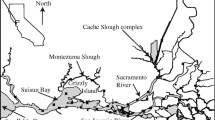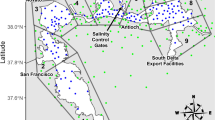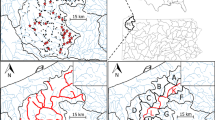Abstract
Quantifying the impacts of disturbances such as oil spills on marine species can be challenging. Natural environmental variability, human responses to the disturbance (e.g., fisheries closures), the complex life histories of the species being monitored, and limited pre-spill data can make detection of effects of oil spills difficult. Using long-term monitoring data from the state of Louisiana (USA), we applied novel spatiotemporal approaches to identify anomalies in species occurrence and catch rates. We included covariates (salinity, temperature, turbidity) to help isolate unusual events. While some species showed evidence of unlikely temporal anomalies in occurrence or catch rates, we found that the majority of the observed anomalies were also before the Deepwater Horizon event. Several species-gear combinations suggested upticks in the spatial variability immediately following the spill, but most species indicated no trend. Across species-gear combinations, there was no clear evidence for synchronous or asynchronous responses in occurrence or catch rates across sites following the spill. Our results are in general agreement to other analyses of monitoring data that detected small impacts, but in contrast to recent results from ecological modeling that showed much larger effects of the oil spill on fish and shellfish.






Similar content being viewed by others
References
Able, K. W., López-Duarte, P. C., Fodrie, F. J., Jensen, O. P., Martin, C. W., Roberts, B. J., Valenti, J., O’Connor, K., & Halbert, S. C. (2015). Fish assemblages in Louisiana salt marshes: effects of the Macondo oil spill. Estuaries and Coasts, 38(5), 1385–1398. https://doi.org/10.1007/s12237-014-9890-6.
Ainsworth, C. H., Paris, C. B., Perlin, N., Dornberger, L. N., Iii, W. F. P., Chancellor, E., et al. (2018). Impacts of the Deepwater Horizon oil spill evaluated using an end-to-end ecosystem model. PLoS One, 13(1), e0190840. https://doi.org/10.1371/journal.pone.0190840.
Baltz, D. M., Thomas, R. G., & Chesney, E. J. (2003). Spotted seatrout habitat affinities in Louisiana. In Biology of the spotted seatrout (pp. 147–175). Boca Raton: CRC Press.
Besbeas, P., Freeman, S. N., Morgan, B. J. T., & Catchpole, E. A. (2002). Integrating mark–recapture–recovery and census data to estimate animal abundance and demographic parameters. Biometrics, 58(3), 540–547. https://doi.org/10.1111/j.0006-341X.2002.00540.x.
Beyer, J., Trannum, H. C., Bakke, T., Hodson, P. V., & Collier, T. K. (2016). Environmental effects of the Deepwater Horizon oil spill: a review. Marine Pollution Bulletin, 110(1), 28–51. https://doi.org/10.1016/j.marpolbul.2016.06.027.
Buskey, E. J., White, H. K., & Esbaugh, E. J. (2016). Impact of oil spills on marine Llife in the Gulf of Mexico: effects on plankton, nekton, and deep-sea benthos. Oceanography, 29(3), 174–181.
Chesney, E. J., Baltz, D. M., & Thomas, R. G. (2000). Louisiana estuarine and coastal fisheries and habitats: perspectives from a fish’s eye view. Ecological Applications, 10(2), 350–366. https://doi.org/10.2307/2641098.
Christmas, J. Y., McBee, J. T., Waller, R. S., & Sutter III, F. C. (1982). Habitat suitability index models: gulf menhaden (No FWS/OBS-82/10.23) (p. 23). Washington, D.C.: U.S. Department of the Interior, Fish and Wildlife Service.
Couillard, C. M., Lee, K., Légaré, B., & King, T. L. (2005). Effect of dispersant on the composition of the water-accommodated fraction of crude oil and its toxicity to larval marine fish. Environmental Toxicology and Chemistry, 24(6), 1496–1504. https://doi.org/10.1897/04-267R.1.
de Mutsert, K., Lewis, K., Milroy, S., Buszowski, J., & Steenbeek, J. (2017). Using ecosystem modeling to evaluate trade-offs in coastal management: effects of large-scale river diversions on fish and fisheries. Ecological Modelling, 360, 14–26. https://doi.org/10.1016/j.ecolmodel.2017.06.029.
Finley, A. O., Sang, H., Banerjee, S., & Gelfand, A. E. (2009). Improving the performance of predictive process modeling for large datasets. Computational Statistics & Data Analysis, 53(8), 2873–2884. https://doi.org/10.1016/j.csda.2008.09.008.
Fodrie, F. J., & Heck, K. L. (2011). Response of coastal fishes to the Gulf of Mexico oil disaster. PLoS One, 6(7), e21609. https://doi.org/10.1371/journal.pone.0021609.
Fodrie, F. J., Able, K. W., Galvez, F., Heck, K. L., Jensen, O. P., López-Duarte, P. C., et al. (2014). Integrating organismal and population responses of estuarine fishes in Macondo spill research. BioScience, 64(9), 778–788. https://doi.org/10.1093/biosci/biu123.
Gelman, A., & Rubin, D. B. (1992). Inference from iterative simulation using multiple sequences. Statistical Science, 7, 457–511.
Geweke, J. (1992). Evaluating the accuracy of sampling-based approaches to calculating posterior moments. In J. M. Bernardo, J. Berger, A. P. Dawid, & J. F. M. Smith (Eds.), Bayesian statistics (Vol. 4, pp. 169–193). Oxford: Oxford University Press.
Graham, N. A. J., Wilson, S. K., Jennings, S., Polunin, N. V. C., Robinson, J., Bijoux, J. P., & Daw, T. M. (2007). Lag effects in the impacts of mass coral bleaching on coral reef fish, fisheries, and ecosystems. Conservation Biology, 21(5), 1291–1300. https://doi.org/10.1111/j.1523-1739.2007.00754.x.
Hall Jr., L. W. H., & Giddings, J. M. (2000). The need for multiple lines of evidence for predicting site-specific ecological effects. Human and Ecological Risk Assessment: An International Journal, 6(4), 679–710. https://doi.org/10.1080/10807030008951334.
Hayley, T. H., Bolton, R. K., & Johnston, C. E. (2010). Invasion of Gulf Menhaden in the Alabama River. Southeastern Fishes Council Proceedings: No. 52. Available at: http://trace.tennessee.edu/sfcproceedings/vol1/iss52/4. Accessed 13 Aug 2018.
Hijuelos, A. C., Sable, S. E., O’Connell, A. M., Geaghan, J. P., Lindquist, D. C., & White, E. D. (2017). Application of species distribution models to identify estuarine hot spots for juvenile nekton. Estuaries and Coasts, 40(4), 1183–1194. https://doi.org/10.1007/s12237-016-0199-5.
Hyndman, R. J., & Khandakar, Y. (2008). Automatic time series forecasting: the forecast package for R. Journal of Statistical Software, 26(3), 1–22.
Incardona, J. P., Swarts, T. L., Edmunds, R. C., Linbo, T. L., Aquilina-Beck, A., Sloan, C. A., Gardner, L. D., Block, B. A., & Scholz, N. L. (2013). Exxon Valdez to Deepwater Horizon: comparable toxicity of both crude oils to fish early life stages. Aquatic Toxicology, 142, 303–316. https://doi.org/10.1016/j.aquatox.2013.08.011.
Incardona, J. P., Gardner, L. D., Linbo, T. L., Brown, T. L., Esbaugh, A. J., Mager, E. M., Stieglitz, J. D., French, B. L., Labenia, J. S., Laetz, C. A., Tagal, M., Sloan, C. A., Elizur, A., Benetti, D. D., Grosell, M., Block, B. A., & Scholz, N. L. (2014). Deepwater Horizon crude oil impacts the developing hearts of large predatory pelagic fish. Proceedings of the National Academy of Sciences, 111(15), E1510–E1518. https://doi.org/10.1073/pnas.1320950111.
Incardona, J. P., Carls, M. G., Holland, L., Linbo, T. L., Baldwin, D. H., Myers, M. S., et al. (2015). Very low embryonic crude oil exposures cause lasting cardiac defects in Salmon and Herring. Scientific Reports, 5, srep13499. https://doi.org/10.1038/srep13499.
Langangen, Ø., Olsen, E., Stige, L. C., Ohlberger, J., Yaragina, N. A., Vikebø, F. B., Bogstad, B., Stenseth, N. C., & Hjermann, D. Ø. (2017). The effects of oil spills on marine fish: implications of spatial variation in natural mortality. Marine Pollution Bulletin, 119(1), 102–109. https://doi.org/10.1016/j.marpolbul.2017.03.037.
Latimer, A. M., Banerjee, S., Sang Jr., H., Mosher, E. S., & Silander Jr., J. A. (2009). Hierarchical models facilitate spatial analysis of large data sets: a case study on invasive plant species in the northeastern United States. Ecology Letters, 12(2), 144–154. https://doi.org/10.1111/j.1461-0248.2008.01270.x.
Louisiana Department of Wildlife and Fisheries (LDWF).(2002). Marine Fisheries Division Field Procedure Manual (Ver. 02‐1). Baton Rouge, LA.
Maechler, M., Rousseeuw, P., Struyf, A., Hubert, M., & Hornik, K. (2018). Cluster: cluster analysis basics and extensions. R package version 2.0.7-1.
Martin, C. (2017). Avoidance of oil contaminated sediments by estuarine fishes. Marine Ecology Progress Series, 576. https://doi.org/10.3354/meps12084.
Matkin, C. O., Saulitis, E. L., Ellis, G. M., Olesiuk, P., & Rice, S. D. (2008). Ongoing population-level impacts on killer whales Orcinus Orca following the “Exxon Valdez” oil spill in Prince William sound, Alaska. Marine Ecology Progress Series, 356, 269–281.
Maunder, M. N., & Punt, A. E. (2004). Standardizing catch and effort data: a review of recent approaches. Fisheries Research, 70(2), 141–159. https://doi.org/10.1016/j.fishres.2004.08.002.
Maunder, M. N., & Punt, A. E. (2013). A review of integrated analysis in fisheries stock assessment. Fisheries Research, 142, 61–74. https://doi.org/10.1016/j.fishres.2012.07.025.
McCrea-Strub, A., Kleisner, K., Sumaila, U. R., Swartz, W., Watson, R., Zeller, D., & Pauly, D. (2011). Potential impact of the Deepwater Horizon oil spill on commercial fisheries in the Gulf of Mexico. Fisheries, 36(7), 332–336. https://doi.org/10.1080/03632415.2011.589334.
Mendelssohn, I. A., Andersen, G. L., Baltz, D. M., Caffey, R. H., Carman, K. R., Fleeger, J. W., Joye, S. B., Lin, Q., Maltby, E., Overton, E. B., & Rozas, L. P. (2012). Oil impacts on coastal wetlands: implications for the Mississippi River Delta ecosystem after the Deepwater horizon oil spill. BioScience, 62(6), 562–574. https://doi.org/10.1525/bio.2012.62.6.7.
Middleton, B. A., Johnson, D., & Roberts, B. J. (2015). Hydrologic remediation for the Deepwater Horizon incident drove ancillary primary production increase in coastal swamps. Ecohydrology, 8(5), 838–850. https://doi.org/10.1002/eco.1625.
Minello, T. J., Zimmerman, R. J., & Martinez, E. X. (2011). Mortality of young brown shrimp Penaeus aztecus in estuarine nurseries. Transactions of the American Fisheries Society, 118(6), 693–708. https://doi.org/10.1577/1548-8659(1989)118<0693:MOYBSP>2.3.CO;2.
Moody, R. M., Cebrian, J., & Heck Jr., K. L. (2013). Interannual recruitment dynamics for resident and transient marsh species: evidence for a lack of impact by the Macondo oil spill. PLoS One, 8(3), e58376. https://doi.org/10.1371/journal.pone.0058376.
Moore, J. W., Yeakel, J. D., Peard, D., Lough, J., & Beere, M. (2014). Life-history diversity and its importance to population stability and persistence of a migratory fish: steelhead in two large North American watersheds. Journal of Animal Ecology, 83(5), 1035–1046. https://doi.org/10.1111/1365-2656.12212.
O’Connor, B. S., Muller-Karger, F. E., Nero, R. W., Hu, C., & Peebles, E. B. (2016). The role of Mississippi River discharge in offshore phytoplankton blooming in the northeastern Gulf of Mexico during august 2010. Remote Sensing of Environment, 173, 133–144. https://doi.org/10.1016/j.rse.2015.11.004.
Peterman, R. M. (1990). Statistical power analysis can improve fisheries research and management. Canadian Journal of Fisheries and Aquatic Sciences, 47(1), 2–15. https://doi.org/10.1139/f90-001.
Peterson, C. H., McDonald, L. L., Green, R. H., & Erickson, W. P. (2001). Sampling design begets conclusions: the statistical basis for detection of injury to and recovery of shoreline communities after the ‘Exxon Valdez’ oil spill. Marine Ecology Progress Series, 210, 255–283.
Petitgas, P., Rijnsdorp, A. D., Dickey-Collas, M., Engelhard, G. H., Peck, M. A., Pinnegar, J. K., Drinkwater, K., Huret, M., & Nash, R. D. M. (2012). Impacts of climate change on the complex life cycles of fish. Fisheries Oceanography, 22(2), 121–139. https://doi.org/10.1111/fog.12010.
Plummer, M. (2003). JAGS: A program for analysis of Bayesian graphical models using Gibbs sampling. In Proceedings of the 3rd International Workshop on Distributed Statistical Computing (Vol. 124, p. 125). Vienna. https://www.r-project.org/conferences/DSC-2003/Proceedings/Plummer.pdf. Accessed 13 Aug 2018.
Plummer, M., Best, N., Cowles, K., & Vines, K. (2006). CODA: convergence diagnosis and output analysis for MCMC. R News, 6(1), 7–11.
R Core Team. (2018). R: A language and environment for statistical computing. Vienna: R Foundation for Statistical Computing.
Rose, K. A., Creekmore, S., & Sable, S. (2017). Simulation of the population-level responses of fish to hypoxia: should we expect sampling to detect responses? In Modeling coastal hypoxia: numerical simulations of patterns, controls and effects of dissolved oxygen dynamics (pp. 359–376). New York: Springer.
Schaefer, J., Frazier, N., & Barr, J. (2016). Dynamics of near-coastal fish assemblages following the Deepwater horizon oil spill in the northern Gulf of Mexico. Transactions of the American Fisheries Society, 145(1), 108–119. https://doi.org/10.1080/00028487.2015.1111253.
SEDAR. (2013). SEDAR 32A - Gulf of Mexico menhaden Stock Assessment Report (p. 422). North Charleston: SEDAR http://www.sefsc.noaa.gov/sedar/Sedar_Workshops.jsp?WorkshopNum=32A.
Shelton, A. O., Thorson, J. T., Ward, E. J., & Feist, B. E. (2014). Spatial semiparametric models improve estimates of species abundance and distribution. Canadian Journal of Fisheries and Aquatic Sciences, 71(11), 1655–1666. https://doi.org/10.1139/cjfas-2013-0508.
Shelton, A. O., Hunsicker, M. E., Ward, E. J., Feist, B. E., Blake, R., Ward, C. L., Williams, B. C., Duffy-Anderson, J. T., Hollowed, A. B., Haynie, A. C., & Handling editor: Ken Andersen. (2018). Spatio-temporal models reveal subtle changes to demersal communities following the Exxon Valdez oil spill. ICES Journal of Marine Science, 75(1), 287–297. https://doi.org/10.1093/icesjms/fsx079.
Su, Y.-S., & Yajima, M. (2015). R2jags: Using R to Run 'JAGS'. R package version 0.5-7. https://CRAN.R-project.org/package=R2jags. Accessed 13 Aug 2018.
Sumaila, U. R., Cisneros-Montemayor, A. M., Dyck, A., Huang, L., Cheung, W., Jacquet, J., Kleisner, K., Lam, V., McCrea-Strub, A., Swartz, W., Watson, R., Zeller, D., & Pauly, D. (2012). Impact of the Deepwater Horizon well blowout on the economics of US gulf fisheries. Canadian Journal of Fisheries and Aquatic Sciences, 69(3), 499–510. https://doi.org/10.1139/f2011-171.
Thorson, J. T., & Ward, E. J. (2013). Accounting for space–time interactions in index standardization models. Fisheries Research, 147, 426–433. https://doi.org/10.1016/j.fishres.2013.03.012.
Thorson, J. T., Shelton, A. O., Ward, E. J., & Skaug, H. J. (2015). Geostatistical delta-generalized linear mixed models improve precision for estimated abundance indices for west coast groundfishes. ICES Journal of Marine Science, 72(5), 1297–1310. https://doi.org/10.1093/icesjms/fsu243.
Underwood, A. J. (1994). On beyond BACI: Sampling designs that might reliably detect environmental disturbances. Ecological Applications, 4(1), 3–15. https://doi.org/10.2307/1942110.
United States Coast Guard (2011). Report of investigation into the circumstances surrounding the explosion, fire, sinking and loss of eleven crew members aboard the mobile offshore drilling unit Deepwater Horizon in the Gulf of Mexico, April 20–22 2010 (Vol 1). MISLE Activity Number: 3721503. https://www.hsdl.org/?abstract&did=6700. Accessed 13 Aug 2018.
van der Ham, J. L., & de Mutsert, K. (2014). Abundance and size of gulf shrimp in Louisiana’s coastal estuaries following the Deepwater Horizon oil spill. PLoS One, 9(10), e108884. https://doi.org/10.1371/journal.pone.0108884.
Ward, E. J., Pess, G. R., Anlauf-Dunn, K., & Jordan, C. E. (2012). Applying time series models with spatial correlation to identify the scale of variation in habitat metrics related to threatened Coho Salmon (Oncorhynchus Kisutch) in the Pacific northwest. Canadian Journal of Fisheries and Aquatic Sciences, 69(11), 1773–1782. https://doi.org/10.1139/f2012-096.
Ward, E. J., Jannot, J. E., Lee, Y.-W., Ono, K., Shelton, A. O., & Thorson, J. T. (2015). Using spatiotemporal species distribution models to identify temporally evolving hotspots of species co-occurrence. Ecological Applications, 25(8), 2198–2209. https://doi.org/10.1890/15-0051.1.
Ward, E. J., Adkison, M., Couture, J., Dressel, S. C., Litzow, M. A., Moffitt, S., Hoem Neher, T., Trochta, J., & Brenner, R. (2017). Evaluating signals of oil spill impacts, climate, and species interactions in Pacific herring and Pacific Salmon populations in Prince William sound and Copper River, Alaska. PLoS One, 12(3), e0172898. https://doi.org/10.1371/journal.pone.0172898.
Acknowledgements
Funding for this project was provided by the National Ocean Service’s analyses of the DWH monitoring data (Project 1CK3GC4P00). KLO was supported by a grant from The Gulf of Mexico Research Initiative to the Coastal Waters Consortium. We thank numerous staff at LDWF who contributed to the data collection and data processing for this project; without their dedicated support, long-term monitoring datasets such as the one used in our analysis would not exist. In particular, Harry Blanchet, Jason Adriance, Mike Harden, and Glenn Thomas. We are also grateful to D. Pauly, L. DePinto, M. Christman, and D. Cacela for providing feedback on earlier versions of these analyses.
Author information
Authors and Affiliations
Corresponding author
Electronic supplementary material
ESM 1
(PDF 357 kb)
Rights and permissions
About this article
Cite this article
Ward, E.J., Oken, K.L., Rose, K.A. et al. Applying spatiotemporal models to monitoring data to quantify fish population responses to the Deepwater Horizon oil spill in the Gulf of Mexico. Environ Monit Assess 190, 530 (2018). https://doi.org/10.1007/s10661-018-6912-z
Received:
Accepted:
Published:
DOI: https://doi.org/10.1007/s10661-018-6912-z




